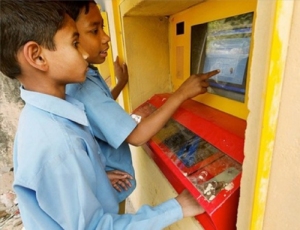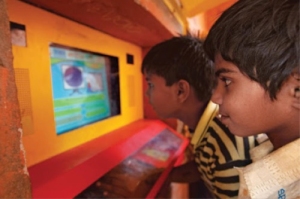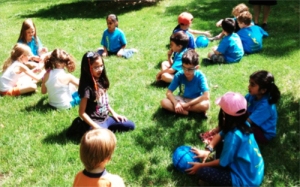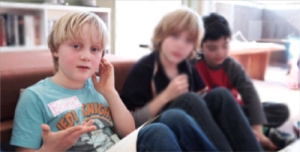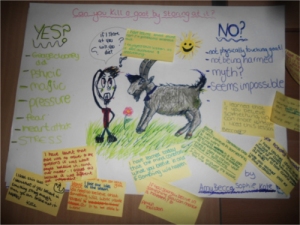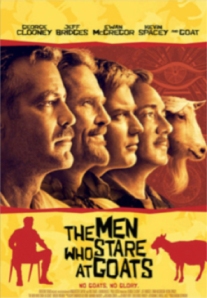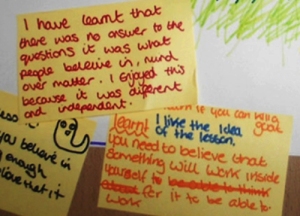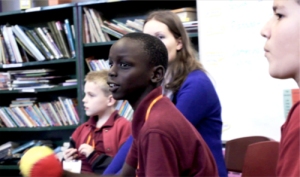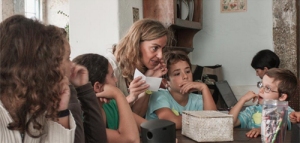How To See Into Their Heads: Picturing a child’s own number line.
‘Miss, why we doing this?’ is something you hear from time to time. And however irritating it might be in tone, it’s a question that deserves an answer. After all, if we are going to take anyone’s time up teaching them anything, we should be able to say why that particular thing is worth the bother. Our reason doesn’t have to be of a narrow ‘you’ll need this to get a job’ type. It could be: ‘Understanding this will make you a better human being in countless ways’, but there must be a sense of purpose in education. Familiarity with our curriculum can allow us to disregard fundamental questions that affect someone coming to the topic for the first time.
Let’s take an example: percentages. Why do children study them? Come to that, why do adults use them? What are they for?
This is a key question because we say nothing with percentages that can’t be said another way. So if 4% of people in my constituency voted UKIP, I could just as easily say that 0.04 of us voted UKIP. Or 4/100. Or I could (sticking with the raw data) say that it was 1971 out of 49 449.
Percentages are actually of course just fractions: they are hundredths. And at some point in the past, someone decided it would be useful to talk about parts of a whole in hundredths. Why? Why not just stick with ordinary fractions?
Well, percentages have one main advantage, which is that they are good for visualising and comparing. So let’s say I want to compare how UKIP did in my neighbouring consitituency – did they do better or worse than in mine? If I am told they got 6%, it is easy for me to compare. I can see immediately that they got more votes there than here, and a moment’s thought tells me that they got half as much again compared to here (4 + 2 = 6). But it is still less than 10%, so not a direct threat to the winner. And I can quickly conclude that even the winner of this seat would consider UKIP’s 4 % worth trying to win over to his own side, unlike the Socialist Party of Great Britain’s share, less than 1%.
All of that strikes me straight away, without me having to puzzle or calculate. Go back to the raw data of 1971 votes out of a 49 449 turnout, however. Is that better or worse than, say, 3707 from 73 788?! I can work it out, but it’s not immediately obvious in the same way.
Although percentages make comparison easier, there is one main disadvantage to them: they are not 100% (enjoy the pun) accurate. So usually when I use a percentage I will be rounding to make the figure into hundredths: 67%, 33%, 8% etc. Except… it’s not actually a disadvantage, it seems. In almost every ordinary life situation, (so, not including specialist financial data) a percentage is accurate enough for our purposes and makes the point we want to make. We simply don’t need the exact data.
How many children are taught that point when they are taught percentages?
It might not seem to matter. It might seem to be the pursuit of curiosity and trivia when there is real work to be done. But the whole procedure of converting data into percentages is meaningless without a reason for doing it. They need to see that they are adding to their skills, understanding or wisdom.
So how do we go about proving to students that percentages make decisions and comparisons easier? The quickest way is to get them to put a set of unwieldy fractions in order of size:
4/7 5/12 16/22 4/9
They can put these in size order if they give every fraction the same denominator. But that’s a big ‘if’, and a big faff. Quicker and easier to divide the top by the bottom on a calculator and note the first two digits after the decimal point (ignore any digits after that). Like this:
0.57 0.42 0.73 0.44
It’s pretty easy to put them order of size now. Percentages, of course, are just these numbers written differently (57 % etc.)
OK, but that’s not the thing. Because I have still made a big assumption. I have assumed that kids can do what we do. Assumed that when fractions are converted to numbers between 0 and 100, kids can now compare them easily, and immediately spot the proportions and relations between them. But can they?
One way to find out is to stretch a line of some kind along the classroom floor. You could make it one metre – there are some advantages to this – but it could be longer, which makes it easier for more people to see and participate. Mark one end 0 and the other 100. You then cut out some triangular pieces of paper with various numbers between and 1 and 99 on them. Do one each, and choose strategic numbers and a few random ones (so 25, 50, 75, 33, 66 and then random ones like 9, 42 etc). Ask the child with the 50 triangle to place it along the line where it should go (if you’ve used triangles then you can use the point of the triangle to mark an exact point on the line). Hopefully, he’ll aim it smack in the middle. If he doesn’t you really have work to do, but the others in the class should be able to help get it to the right place. Then ask children who are confident they know where theirs goes to step forward and put their triangle point on the line. Others can comment and suggest adjustments.
What you will see is the children’s own number lines – how it looks in their heads. These emerge as they make their attempts to divide the line visually and make an estimate of distance and proportion.
Now I guarantee that most basically educated adults, whatever their perceived ability at maths, would be able to divide the line into halves, quarters or thirds in their minds – perhaps tenths too. They would then place their triangle on the correct side of these points. For example, if you had the 40 triangle, you would know it goes on the left of the halfway point 50, because it’s lower. You might then imagine the line divided into tenths and judge one tenth left of 50. Or you imagine it divided into thirds and place your 40 slightly closer to the third point (because it’s 7 away from 33, which is a third) than the half (which is 10 away from 50).
People who have to do this for practical purposes, like builders, may well have better judgment. Perhaps artists would too.
Some children can do this kind of a thing a bit. Others barely at all. They will see this for themselves when you measure out the line. By the way, this is where it is good to have a metre-long line after all because you don’t have to convert the distances into hundredths, it’s already there in the cm markings. Alternatively, you could make a long line that has the correct markings on the underside that can be revealed when you flip the line over at the end.
There is certainly a big difference between what children of average ability manage and what adults of any ability at all can do. But if most of the students can’t do it well, then a lot of the purpose of percentages is lost on them. Knowing, for example, that a rise of 18 to 26% takes you past the 25% mark is the whole point. Without a grasp of these milestones, percentages don’t help nearly as much in appreciating the significance of data.
What should we do? Try to help them develop their mental number line, perhaps. Her are some some suggestions…
- Get children estimating all kinds of distances under 1m and checking their accuracy until they develop a feel for where numbers between 1-100 are on the scale. Some children will do this competitively in their breaks.
- Get children practising questions like ‘Is 67 closer to 55 or 75?’. See how they visualise it in their own drawings and help them to settle on strategies that help.
- Get children to choose which way to represent parts of a whole (common fractions, decimal fractions or percentages) when doing a task – make sure it’s not always decided in advance by the rubric of the question.
- So that they can succeed at point 3, make sure children experience the practical value of the three different ways of talking about amounts between 0 and 1. When I say ‘practical’ I include practical for completing calculations as well as problems in everyday life.
- Always let children show you how they see numbers fitting together. Don’t be in a rush to straighten out the wonky bits. Instead, help the child build a better map of the ‘numberverse’ in a way that they understand.
The first part of this blog is an abridged version of Go Compare, my chapter on percentages in The Numberverse. http://www.philosophy-foundation.org/resources/philosophy-foundation-publications/the-numberverse The second part is something I did in a classroom once with results that surprised me.



